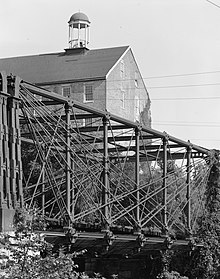Bollman truss
| Bollman Suspension and Trussed Bridge | |
|---|---|

Bollman Bridge with Savage Mill tower in background, 1970
|
|
| Carries | Savage Mill Trail |
| Crosses | Little Patuxent River |
| Locale | Savage, Maryland |
| Characteristics | |
| Design | Bollman Truss |
| Material | cast and wrought Iron |
| Total length | 160 feet (48.8 m) |
| Longest span | 2 × 80 feet (24.4 m) |
| No. of spans | 2 |
| Piers in water | 1 |
| Load limit | 36 tons (72000 kips) |
| History | |
| Designer | Wendel Bollman |
| Construction end | 1869 |
|
Bollman Suspension and Trussed Bridge
|
|
| Location | Savage, Maryland |
|---|---|
| Coordinates | 39°8′5″N 76°49′31″W / 39.13472°N 76.82528°WCoordinates: 39°8′5″N 76°49′31″W / 39.13472°N 76.82528°W |
| Area | 4 acres (1.6 ha) |
| Built | 1869 |
| Architect | Bollman, Wendal |
| Architectural style | Other |
| NRHP Reference # | 72000582 |
| Significant dates | |
| Added to NRHP | October 18, 1972 |
| Designated NHL | February 16, 2000 |
The Bollman Truss Railroad Bridge at Savage, Maryland is the sole surviving example of a revolutionary design in the history of American bridge engineering. The 160-foot (48.8 m) double-span truss bridge is one of the oldest standing iron railroad bridges in the United States; currently, however, it is in use carrying the Savage Mill Trail across the Little Patuxent River. It was the first successful all-metal bridge design to be adopted and consistently used on a railroad. The type was named for its inventor, Wendel Bollman, a self-educated Baltimore engineer.
The bridge was built for an unknown location on the main line of the Baltimore and Ohio Railroad in 1852, and was moved to its present location, spanning the Little Patuxent River on the spur to the Savage Mill, in 1887. This spur line dates to around 1840 and originally crossed the river on a stone arch bridge; however, due to alterations to the mill in the 1880s and topographical restrictions, a replacement bridge was needed. The bridge remained in service until the mill closed in 1947; switching crews used additional cars in order to avoid crossing the bridge with locomotives, and thus there was never a need for a more substantial structure. A smaller, narrower example was installed adjacent to the railbridge for road traffic, which was torn down after World War I.
It was the first successful all-metal bridge design to be adopted and consistently used on a railroad. The design employs wrought iron tension members and cast iron compression members. It was an improvement over wooden structures, as the independent structural units lessened the possibility of structural failure. Patented on January 6, 1852, the company built about a hundred of these bridges through 1873. Their durability and ease of assembly greatly facilitated expansion of American railroads in this period. Bollman's Wells Creek Bridge has also survived, but it employs a different type of truss system.
...
Wikipedia


